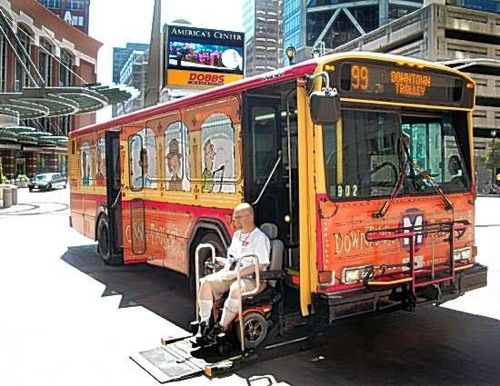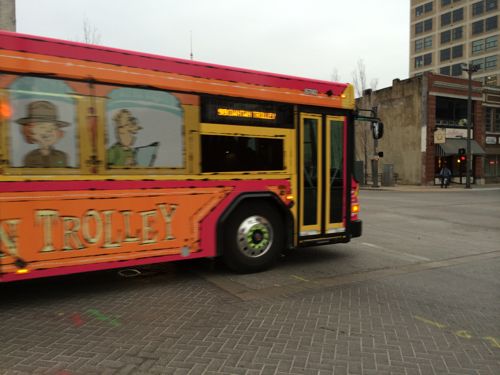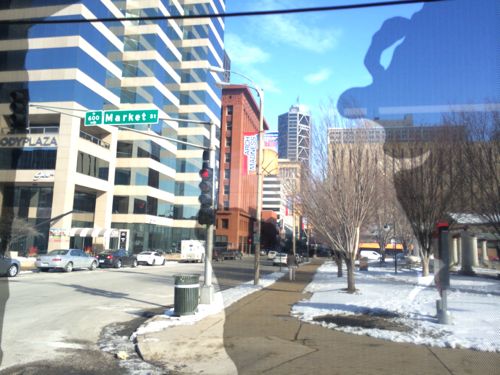Wrap on New Downtown Trolley Buses a Great Improvement
The #99 Downtown Trolley, regular buses with a cartoon wrap, have been on the streets since July 2010. People laugh at the wrap but it’s effective.

The one problem with the original is the wrap made it impossible to see out the side windows. Tourists & locals unable to see the city….no good. Recently the original trolley buses were replaced by new Gillig low-floor buses.


I love the new Gillig low-floor buses, so much quicker & easier to board/unboard, but the ability to see out is a huge improvement, a very pleasant surprise! The wrap is licensed from a company that holds the rights to use a trolley likeness.
— Steve Patterson
Both the low-floor buses and the new wrap are definitely improvements. One of the big things that an actual trolley has that these lack are tracks–these allow casual riders to easily see that “the trolley goes by here”. Since buses obviously have no tracks, perhaps they could paint the trolley route directly on the street? Here’s a similar idea: http://www.mine-control.com/zack/bus/bus.html
Better yet, consider a switch to electric trolley buses – no tracks in the street, but with wires above: http://upload.wikimedia.org/wikipedia/commons/7/73/Vancouver_trolley2101_050720.jpg
Not a bad idea but far more expensive than just paint on a road. You’d have to install the power lines and buy new buses.
Yes, more expensive. The real questions are goals and resources. Paint ain’t permanent, and the city probably won’t pay for it, so should Metro eliminate one whole bus route so they can spend that money painting stripes every year? For people who can’t figure out a schedule and/or don’t want to create a customized “trip” online for all their remaining routes?! But if you’re concerned with branding and minimizing confusion, how about investing in distinctive, informative, well-maintained bus shelters for every stop? Less confusion and a better expenditure of limited resources!
And the advantages of trolley buses would be more than just identifying the route(s), they would use cleaner electric power and they would require less maintenance, the same arguments streetcar advocates make. They would do this for less money than streetcars, but would avoid all the issues associated with laying tracks.
we should eleminate about 50% of the routes and add frequency in places that make sense
. . . and those would be . . . . the ones you don’t use?! What part of regional and system don’t you get? Yes, adding frequency, across the system, would “make sense”. Unfortunately, that takes one big thing, mo’ money! And with service inside the city already being subsidized by taxpayers outside the city, be careful of what you ask for . . . .
its stupid, the region is built for cars, the city isnt, you figure it out genius
Employment in the region: 1,258,698
Employment in the county: 575,924
Employment in the city: 221,384
http://www.bls.gov/ro7/stlouis_summary.htm
Population in the region: 2,795,794
Population in the county: 1,000,438
Population in the city: 318,172
http://en.wikipedia.org/wiki/Greater_St._Louis
“Genius” says the county needs twice as much service as the city does. Times change, you need to provide service where the people are and where the people want to go. Plus, public transit is very much a chicken-or-egg proposition – better service attracts more riders, while crappier service discourages both potential and actual riders. Combine that with the fact that 75%-80% of the cost of EVERY trip taken on public transit is subsidized with tax dollars, and you damn well better keep the voters in the county happy about what little service they do receive – the city is in no position to fully subsidize the levels of service that Metro is currently providing within the city.
Jobs per square mile:
St. Louis County: 1,099
St. Louis City: 3,344
Metro cannot possibly cover all 524 square miles of St. Louis County with the same level of service.
Nor should they, but they should provide service to areas that are employment centers and population centers – they do not need to provide service to the acres of stuff that city folk don’t want inside the city, things like airports and landfills . . . .
Not a bad idea but far more expensive than just paint on a road. You’d have to install the power lines and buy new buses.
Here’s a better idea – integrate public transit and bars: http://www.thrillist.com/drink/chicago/chicago-s-first-cta-bar-map-thrillist-chicago
Tangentially related – successful streetcar systems are faster than buses, just not “better” buses, playing in the same traffic: http://nextcity.org/theworks/entry/the-key-to-surviving-the-great-american-streetcar-closures-dedicated-space